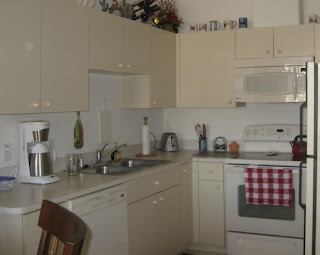
The kitchen is a room where chaos can strike at a moments notice, but fortunately it’s one of the easiest rooms to keep organized; once you get it arranged. Most kitchen areas come already compartmentalized with a stove, a sink, a refrigerator and cabinets, thus you have a template to work with, and it’s just a matter of designing your personal storage plan.
Let’s start with the stove area:
1. A food prep area based on the flow of your counter, usually on the side closest to the sink. So that you can clean your food then take it to the prep area with minimal mess and fuss.
2. The stove, it should be clear; only the pots and pans you are working with. Make sure nothing flammable is in the immediate vicinity. Any spices you are going to use for your food should be within reach but not above the stove; many a dinner has been ruined by a wayward spice falling off the shelf into the pot.
3. On the other side of the stove is the “pull-off” area, a place where you can safely put the hot pan. This area should have some sort of heat proof pad, and make sure that the pot is not going to fall. By having an immediate pull off area you can control the cooking process quite easily, and with a big enough area you can portion the food for serving.
The refrigerator:
1. Don’t over stuff your refrigerator, there needs to be airflow to effectively keep your foods cool.
2. Food rotation is very important, otherwise you’ll end up with a funky smell emanating from somewhere in the refrigerator, first in, first out is a good rule of thumb. Also if you have a question how long you can store a particular food check out https://stilltasty.com/
3. Where’s the freezer? This is a matter of personal taste and what’s convenient for you; some have a top freezer, others a bottom freezer, or a side freezer. I prefer the bottom freezer, because I don’t get things out of the freezer that often and I don’t want to have to bend over to see what’s in the refrigerator.
The pantry, a place to store cereals, pasta, rice, and other dry goods and canned products:
1. Foods that come in boxes should be used completely, where practical otherwise store the unused portion in an air tight container, to keep the food as fresh as possible. These containers also lend themselves to a more efficient use of your cupboard space.
2. Once a box of cereal is opened it’ll never be as fresh as it was before you opened it, because it’s very hard to seal that bag in the box. I suggest transferring your cereal to sealable container or a zip lock type bag to preserve freshness and to keep out bugs.
3. Tuna in a can or tuna in a pouch that is the question. Cans are stackable and they recycle easier, they can also be “repurposed”. In the end it’s a matter of choice, I prefer the cans of tuna or chicken at home, but if I’m camping or traveling, the pouch sure is handy. Remember to take care of these containers in a way that helps the planet stay green.
The drawers:
1. Arrange your drawers according to the work area they are near, so that they are close at hand when you need them. For example, in the food prep area of your counter the drawer should have various knives and the other tools for preparing your meal. The drawer near the pull off area should have tools for portioning and serving.
2. The drawer nearest to the plates and bowls should be where you find eating utensils and smaller serving implements.
The cabinets can be arranged by frequency of use and proximity to the various work areas. Usually pots and pans are stored in the bottom cupboards, unless you have one of those hanging racks for your pans.
Through thoughtful consideration I’ve been organizing my kitchen, if not for any other reason than sanity, the points above are some of the ideas I’ve found to be most helpful.




No comments:
Post a Comment